March 6, 2019, by Kathryn Steenson
The Bigger Picture
This is a guest post by Anjali, an Politics and Economics student, written as part of the Nottingham Advantage Award run by the Careers and Employability Service.
Culture and heritage forms a big part of an individual’s identity. As an individual who is a young British Indian woman, living in a world where a person such as Donald Trump is the President of the most powerful country in the world – where do I fit in? Are we repeating history or are we learning from it? How can we move on and see a bigger picture from what we have been conditioned to see.
Undertaking the Experience Heritage module as part of the NAA, has deepened my knowledge of my heritage and culture. Being both British and Indian has meant that I have had to balance these two incredible yet distinct cultures. This module has not only given me the opportunity to learn more about myself, but have the chance to display India’s rich culture.
We often attach stigmas to certain things, types of people and countries which at times masks us from seeing the bigger picture. India in the past has been associated with colonialism and as a country that has been politically and socially divided. Whilst, we should acknowledge that this is a part of India’s history this is not the real India, this is not my India, and I am passionate about changing this perception especially in the West.
During my placement, I have had the opportunity to gain hands on experience of working in the heritage sector, where around 16 hours has been dedicated to source based research and the other 19 hours has been set for creating and executing my own display. Looking through the University’s archives and manuscripts, I aimed to find materials that displayed India’s vibrant culture including its amalgamation of religions, festivals, dance and music.
Bharatanatyam is a form of Indian Classical Dance and is regarded as the mother of all Indian classical dances. This dance traces back to ‘Natya Shastra’, the ancient Sanskrit Hindu text on the performing arts, where the dancer normally emotes spiritual ideas and illustrative Hindu religious themes through footwork and gestures.
India is also a land of unity and diversities, where the major religions of India are Hinduism, Islam, Sikhism and Christianity. Hinduism is the oldest religion in the world, where it is a polytheistic religion which is populated with myriad gods and goddesses who personify aspects of the one true God.
Thus it should be acknowledged that India’s rich culture of dance, music, spirituality and religion is the core foundation of this great civilisation.
Manuscripts and Special Collections is at King’s Meadow Campus. For more information about our holdings or to view any of our material in the Reading Room, please see our website. You can also follow us on Twitter @mssUniNott.
No comments yet, fill out a comment to be the first




Leave a Reply